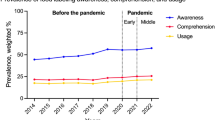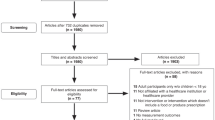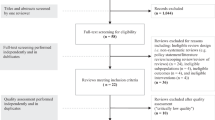Abstract
In a pilot study, we wanted to influence the food selection of employees in a pediatric clinic bistro aiming to increase the sale of “healthy” grain buns (number and proportion of all sold buns). During basic assessment, the mean weekly sale of grain buns was 98 (52.3%) and in the second week of highlighting them on a green napkin under a transparent hood (intervention 1) reached 124 (54.6%). However, just when starting intervention 2 (position in front of the display), the bistro was closed due to the Coronavirus pandemic. Thus, necessary public health measures stopped our interventional public health experiment.
Similar content being viewed by others
Introduction
Food nudging is a new promising approach to modify food decisions by using neuro-economic concepts. The concept of “nudging” aims to subliminally steer the behavior of people in automatic decisions through small recurring impulses from the environment. Food nudging is intended to set unconscious incentives for a specific food selection. Such incentives are, for example, the product name, easy availability or priority placement on the sales shelf [1]. This approach is promising for nutrition, since eating decisions are mostly made intuitively, habitually and spontaneously, not only by children and adolescents but also adults [2].
In an earlier experimental study by the Research Department for Child Nutrition (FKE), elementary school children were served a snack (fruit yoghurt with whole-grain cereals) of the Optimized Mixed Diet, a preventive dietary concept, in transparent beakers with various stickers. With the name “Knabbadus” and an additional image of parrots, the product “tasted better” for the children and they also tried harder to get the product than with the simple name “fruit yogurt with cereals” and without animal pictures [3].
Changing the food selection in adults with long-established eating habits seems particularly difficult [4]. In a pilot study, we wanted to influence the food selection of employees of a children’s clinic in the bistro. The goal was to increase the proportion of “healthy” grain buns at the expense of bright buns.
Subjects and methods
The pediatric university clinic is part of the Josefs-Hospital, a large academic hospital in Bochum. The inside bistro of the pediatric clinic is operated by the hospital’s food and nutrition services. The bistro serves mainly employees 6 days a week in the daytime. Nudging measures at the clinic bistro were highlighting of grain buns by placing them on green napkins under a transparent hood (intervention 1), followed by a redesign of the dispensing area with putting grain buns in front of the display and the bright buns in the back (intervention 2), and finally attaching an advertising board for grain buns (intervention 3). The planned schedule was basic assessment (2 weeks), intervention 1 (2 weeks), washout (1 week), intervention 2 (2 weeks), washout (1 week), intervention 3 (2 weeks). Primary outcome variable was the sale of grain buns (number and proportion of all sold buns). The sales system in the bistro recorded all the food on offer (categorized including different types of bread rolls) and separately for items delivered, sold, and returned (daily lists). The study protocol was approved by the Committee for Ethics of the Faculty of Medicine at the University of Bochum.
Results
Basic assessment showed a sale of grain buns (% of sold buns) of 92 (52.3) during week 1 and 104 (52.3) during week 2. During the first intervention 90 (50,3) grain buns were sold in week 1 and 124 (54,6) in week 2. During washout (1 week) we counted 102 (63,8) and in the first week of the second intervention 101 (62,0). At the beginning of week 2 of the second intervention, the bistro was unexpectedly closed as part of restrictive public health measures in response to the Corona-pandemic (Fig. 1).
Discussion
The study attempted to move components of healthy eating in the desired direction. In particular, this study investigated whether an intervention to increase the visibility and accessibility of “healthy” grain buns in a clinic bistro increased the sale of these items (as is explicitly recommended in the optimized mixed diet). However, our pilot study, which proved to be feasible in the bistro routine, was stopped by restrictive public health measures due to the Corona-pandemic and did not achieve reliable results.
The Research Department of Child Nutrition (FKE) is part of the Pediatric University Clinic, Ruhr University, Bochum, Germany, since 2017. The FKE works on basic and application-oriented questions to optimize nutrition in all phases of growth and development. The calculated concept of the Optimized Mixed Diet of the FKE provides a reference frame for preventive nutrition among children and adolescents in Germany [5]. It is applicable to the nutrition of healthy and diseased children, in families, day care centers, schools and in pediatric hospitals as well.
The prevalence of obesity is increasing in all industries, including employees of the health care sector [6]. Food nudging seems a promising new approach to support healthy food choices. Nudging can serve as a complement to health education [7]. Just recently, it was demonstrated that situated nudging and social marketing-based strategies were effective in promoting healthier choices of employees in their worksite cafeterias [8], also in a hospital cafeteria [9]. Further research is warranted to investigate this topic in clinic bistros and canteens as promoting healthy dietary choices at the working place could ultimately help prevent and reduce obesity of employees in the health system.
On the one hand, this report shows a practical concept for examining the effects of nudging interventions in a children’s hospital. On the other hand, we highlight different aspects and levels of public health. In the present case, necessary public health precautions stop a study that examines nudging as a promising public health incentive. We want to share our feelings, namely that we as nutritionists are disappointed because we have only been able to demonstrate the feasibility but not the success of our nudging measures, combined with an understanding of these sudden changes in clinical routine due to necessary public health interventions as a response to the corona-pandemic.
References
Winkler G, Berger B, Filipiak-Pittroff B, Hartmann A, Streber A. Small changes in choice architecture in self-service cafeterias. Do they nudge consumers towards healthier food choices? Ernahr Umsch. 2018;65:170–8.
Wilson AL, Buckley E, Buckley J, Bogomolova S. Nudging healthier food and beverage choices through salience and priming. Evidence from a systematic review. Food Qual Pref. 2016;51:47–64.
Enax L, Weber B, Ahlers M, Kaiser U, Diethelm K, Holtkamp D. et al. Food packaging cues influence taste perception and increase effort provision for a recommended snack product in children. Fron Psychol. 2015;6:882. https://doi.org/10.3389/fpsyg.2015.00882.
Arno A, Thomas S. The efficacy of nudge theory strategies in influencing adult dietary behaviour: a systematic review and meta-analysis. BMC Public Health. 2016;30:16. https://doi.org/10.1186/s12889-016-3272-x.
Kersting M, Alexy U, Clausen K. Using the concept of Food Based Dietary Guidelines to Develop an Optimized Mixed Diet (OMD) for German children and adolescents. J Pediatr Gastroenterol Nutr. 2005;40:301–8.
Centers for Disease Control and Prevention Worker health charts: health and safety behaviors. https://wwwn.cdc.gov/Niosh-whc/topic/behavior. Accessed 15 Apr 2020.
Broers VJV, Céline De Breucker C, Van den Broucke S, Luminet O. A systematic review and meta-analysis of the effectiveness of nudging to increase fruit and vegetable choice. Eur J Public Health. 2017;27:912–20.
Velema E, Vyth EL, Hoekstra T, Steenhuis IHM. Nudging and social marketing techniques encourage employees to make healthier food choices: a randomized controlled trial in 30 worksite cafeterias in The Netherlands. Am J Clin Nutr. 2018;107:236–46.
Thorndike AN, Gelsomin ED, McCurley JL, Levy DE. Calories purchased by hospital employees after implementation of a cafeteria traffic light-labeling and choice architecture program. JAMA Netw Open. 2019;2:e196789. https://doi.org/10.1001/jamanetworkopen.2019.6789.
Author information
Authors and Affiliations
Contributions
The contributions of the authors were as follows: MK, HK, and CG designed research; MK coordinated the study parts; TL supervised the intervention trial; SV and FA managed study program; HK and MK analyzed data and drafted manuscript. All authors contributed to interpretation of the data and revisions of the manuscript.
Corresponding author
Ethics declarations
Conflict of interest
The authors declare that they have no conflict of interest.
Additional information
Publisher’s note Springer Nature remains neutral with regard to jurisdictional claims in published maps and institutional affiliations.
Rights and permissions
About this article
Cite this article
Kalhoff, H., Voss, S., Abram, F. et al. Fate of a food nudging intervention during the Corona-pandemic: unexpected shopping ban on a small clinic bistro. Eur J Clin Nutr 75, 209–211 (2021). https://doi.org/10.1038/s41430-020-00728-x
Received:
Revised:
Accepted:
Published:
Issue Date:
DOI: https://doi.org/10.1038/s41430-020-00728-x




